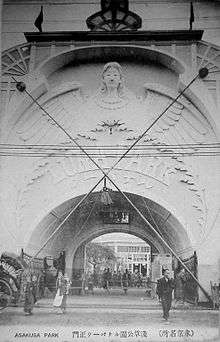Luna Park, Tokyo

In operation in 1910 and 1911, Tokyo's Luna Park (Runa pāku, also known as Asakusa Luna Park)[1] was the first park of that name to be open in Japan. Owned and constructed by the Japanese motion picture company Yoshizawa Shōten (headed by Ken'ichi Kawaura) in the Tokyo suburb Asakusa,[2] the park was designed to mimic the original Luna Park that was built in Brooklyn, New York in 1903.[3]
Despite its popularity, the park existed for only eight months, burning down in April 1911.[4][5] Luna Park was incinerated under suspicious circumstances[6] at roughly the same time that two theaters owned by Yoshizawa Shōten also succumbed to fire in Osaka.[7]
The trio of disasters struck Kawaura and his company at their most vulnerable time. The Japanese film industry was being besieged by inroads by a consortium of their American counterparts. Kawaura, tiring of the travails of working with Yoshizawa Shōten, sold the company to Shōkichi Umeya (owner of M. Pathe) for the equivalent of $375,000 USD.[8] Kawaura then decided to build a new Luna Park, not in Tokyo but in Osaka instead. The new park opened in 1912 and stayed in business until 1923.[9]
References
- ↑ Isolde Standish A New History of Japanese Cinema: A Century of Narrative Film (Continuum International Publishing Group 2006) ISBN 0-8264-1790-6
- ↑ The Problem of Cinema - Swarming Ants and Elusive Villains: Zigomar and the Problem of Cinema in 1910s Japan
- ↑ Miodrag Mitrašinović, Total Landscape, Theme Parks, Public Space (Ashgate Publishing 2006) ISBN 0-7546-4333-6
- ↑ Comments in Sakutarō Hagiwara's Rats' Nests: The Collected Poetry of Hagiwara Sakutarō (Yakusha 1993) ISBN 1-880276-40-2
- ↑ Joseph L. Anderson and Donald Richie, The Japanese Film: Art and Industry (Princeton University Press 1982) ISBN 0-691-00792-6
- ↑ Isolde Standish, A New History of Japanese Cinema: A Century of Narrative Film (Continuum International Publishing Group 2006) ISBN 0-8264-1790-6
- ↑ David Richard Ambaras reports in Bad Youth: Juvenile Delinquency and the Politics of Everyday Life in Modern Japan (University of California Press 2006, ISBN 0-520-24579-2) that the popular park acquired a reputation for harboring juvenile delinquency, citing a 1911 article in New Review (Shin kóron), in which there were accounts in which local officials either ignored or supported the activities of pickpocket gangs in Asakura.
- ↑ Joseph L. Anderson and Donald Richie, The Japanese Film: Art and Industry (Princeton University Press 1982) ISBN 0-691-00792-6
- ↑ "History of Shinsekai - Re-use of the Expo Ground". Archived from the original on 19 September 2016.